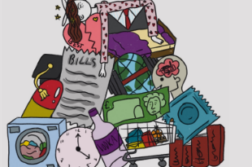Disclaimer: The views expressed within this article are entirely the author’s own and are not attributable to Wessex Scene as a whole.
In the past couple of years, the troubling nature of fast fashion has entered everyone’s minds. With overconsumption of cheap products at an all-time high, people are demanding more sustainable practices within the fashion industry, both in terms of labour and the environment. In response, a wide range of sustainable clothing ranges and brands have popped up, promising ethical treatment of workers and small carbon footprints. But are these sustainable fashion ranges really that different from the fast fashion we’re used to seeing stocked on the shelves of the high street? In the hands of eco-capitalism, sustainable fashion has become reduced to a buzzword with little to no real meaning.
At the core of this problem lies the fundamental misunderstanding of the concept of fast fashion. Fast fashion is not just SHEIN, Pretty Little Thing and Boohoo. The concept has been reduced to referring to internet chains that produce high fashion replicas within a day’s notice and sell bikinis for 5p on sale. While it is certainly true that these chains are a huge part of the problem, they’re far from the only culprits. A higher price tag does not equate to sustainability, yet brands like Zara and Monki have been falsely labelled as sustainable or slow fashion simply because they set their prices higher and sometimes offer unique designs. The concept of a small business has also often been made synonymous with a sustainable business, even though many startups use fabrics and materials produced via near-slave labour just like the fashion giants. Many small businesses may be better in one way or another, but better does not mean good, and in the impending doom of the climate crisis we cannot afford to make assumptions about the sustainability of our future.
Right now, sustainability sells and most large corporations participate in greenwashing to some extent. The term was coined by Jay Westerveld back in the 1980s, and it should now more than ever be at the centre of our environmental concerns. Greenwashing occurs when a company or organisation markets itself as environmentally friendly without following through on their promises. It is a marketing ploy used to mislead customers into continuing their dangerous overconsumption while easing their minds and eradicating guilt. Greenwashing is made easily accessible to corporations due to vague laws surrounding the language they use. Terms like conscious, eco-friendly, negative impact and sustainable are not regulated and they have very little legal meaning, which means that they are often branded on clothing and products that are in actuality still very damaging to our environment. For example, H&M offers a ‘Conscious‘ range, and proudly displays recycling boxes in their stores. If you drop off old clothing in the recycling bins, you receive a discount on new items from the stores. At first glance, that sounds great, but not only does this encourage customers to continue over-consuming H&M’s ethically dubious clothing, but moreover, only approximately 35% of the clothing collected in said boxes is actually recycled.
Garments made out of recycled plastics still require literal tonnes of water and carbon dioxide. Even clothes produced by recycled plastic will continually shed micro-plastics that damage the environment, and will likely eventually end up in a landfill with the rest of our briefly used items. Even the most sustainably produced products in one way or another depend on exploitative labour, and functions on a supply and demand basis where capital ways heavier than consciousness. Such is the very nature of capitalism: in order to stay afloat in an oversaturated market, companies must use marketing ploys that encourage overconsumption.
Slow fashion is not the be-all and end-all solution to our environmental concerns. We still produce way more garments than we could ever use, with the Global Fashion Agenda predicting that the volume of apparel produced is likely to increase by 81% by 2030. Sure, that one sustainable top might have consumed x, y and z amounts more of water if produced in a traditional fast fashion factory, but if you purchase ten of them instead of one traditionally produced top, the effort to shop sustainably makes no attainable difference. At the end of the day, the biggest threat to our environment within the fashion industry is overconsumption. Doing a large haul at Primark once a year is better than ordering a package a month from various small or sustainable businesses, even if that package comes in a recycled mailing bag. If you are able to buy items made from recycled materials, then by all means please do so, as long as you don’t use that as an excuse to ignore overconsumption. We cannot look at sustainable fashion as a solution to fast fashion when the only way to truly develop sustainable shopping habits is to shop less and keep our clothes for longer.



